Updated January 16, 2024
Cycling is a great way to explore exciting places, and cycling Taroko Gorge in Taiwan is no exception. What makes cycling down Taroko Gorge different is that it’s an exhilarating downhill ride through magnificent scenery. Regarded as Taiwan’s number one tourist attraction, Taroko Gorge is an impressive 19-km (12-mile) long marble-walled canyon. It lies beside Taiwan’s east coast, where the mountains fall sharply into the Pacific Ocean.
Table of Contents
Taiwan’s Taroko Gorge
Taroko means ‘magnificent and splendid’ in the language of the aboriginal Truku tribe. Enough said.
Carved into the side of the gorge is a section of the Central Cross-Island Highway. The narrow, winding mountain road affords spectacular views of the river below and towering cliffs and mountains above. Numerous hiking trails and paths radiate from the road, leading to several scenic treasures. Several bridges offer additional vantage points. It’s the perfect place to actively experience one of the scenic wonders of Asia.
Taroko Lodge bike-and-hike services
What could be more convenient than combining accommodation with bike-and-hike services? Taroko Lodge offers both. Located on the outskirts of Taroko National Park, Taroko Lodge is strategically situated for cycling Taiwan’s Taroko Gorge.
The owner, Rihang Su, provides bike rental and transportation to the top of the gorge. Rihang, or his son Jun, also offers suggestions on which trails to incorporate in the time one has available. If the weather cooperates, Rihang’s recommendations on a self-guided bike-and-hike tour have all the ingredients of a perfect day.
As luck would have it, the only other guests at Taroko Lodge on my first night were a brother and sister travelling duo from Germany — Birte and Kai Schulz. At breakfast on the lodge deck the next day, I was delighted to learn Birte and Kai were also taking advantage of the bike-and-hike option.

During breakfast, Rihang set out a selection of bikes. After we chose our rides, he helped adjust the seats before loading them on the van’s bike carrier.
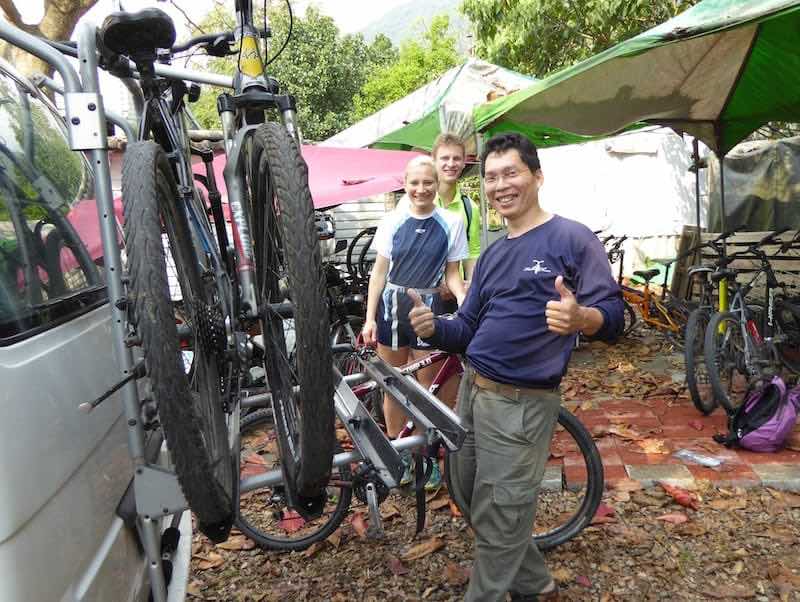
Cycling Taroko Gorge in Taiwan
Starting at the top of the gorge (or close to the top) feels like cheating. It translates into freewheeling twenty kilometres or so down to the park entrance. From there, it’s a short three-kilometre ride to Taroko Lodge.
As Rihang drove us up the gorge, my anticipation and excitement at experiencing Taroko gradually turned to trepidation as I realized how narrow the road was. There were no bike lanes and barely enough room for the massive tour buses and trucks to claim the space each one needed. I pictured David and Goliath, and I wasn’t looking forward to taking on those mechanical giants on such a narrow ribbon of highway.
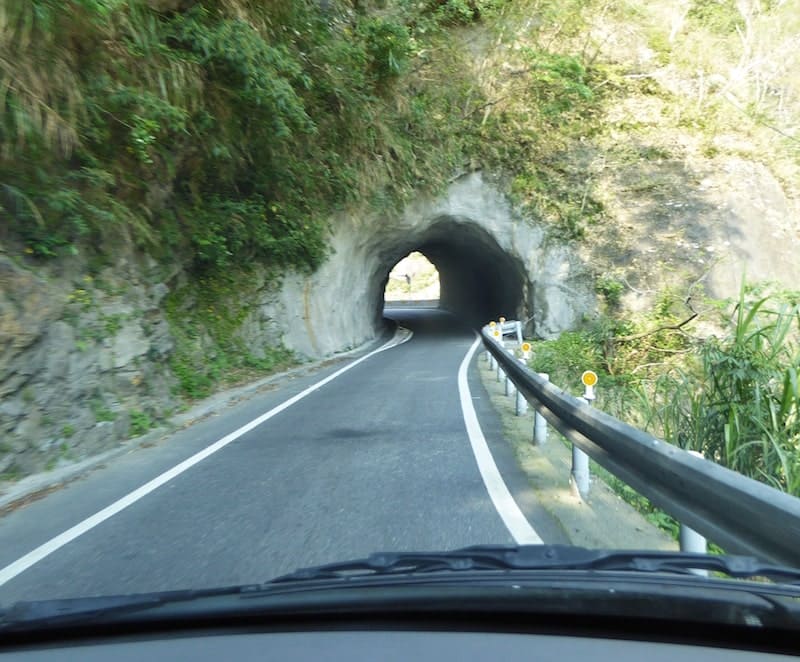
Wenshan Hot Spring
On Rihang’s recommendation, our starting point was the trailhead for Wenshan Hot Spring. Wenshan Hot Spring is easily accessed via a suspension bridge, a few switchbacks and many flights of steps down to river level. The slight smell of sulphur in the mountain air, the bearably hot water to the touch, and the steam rising from the spring water pleasingly invaded the senses.
Baiyang Waterfall Trail
At the entrance to the Baiyang Waterfall Trail, the sign offered tips for a successful hike. Safety helmet? Check. Surely, our cycling helmets fit the bill. Flashlight? Check. Venomous WHAAAT? A quick consultation of our park brochure revealed that snakes and wasps were only an issue in summer and autumn. I was visiting during the northern spring. Whew.
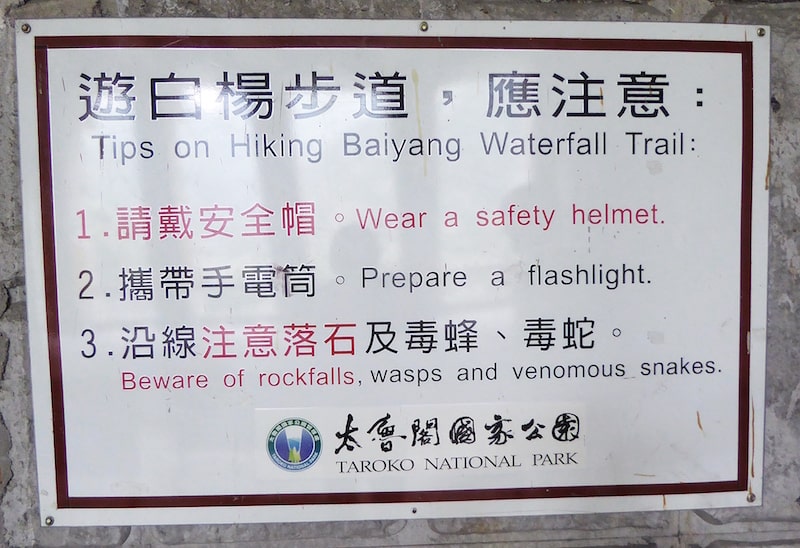
We parked our bikes at the trailhead of the two-kilometre-long Baiyang Waterfall trail winding its way along the river through seven tunnels. Several were long and curved, with an absence of natural light. I was thankful we had a flashlight.
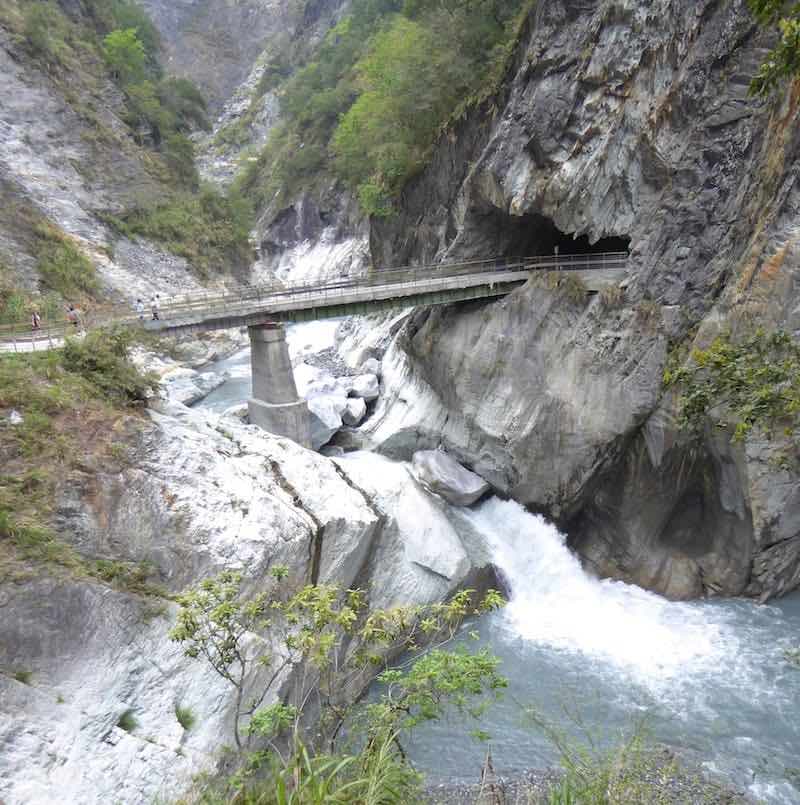
The Baiyang Waterfall Trail brought an unexpected treat. On our maps, the Water Curtain Cave (Shuiliandong) was indicated as closed, so we were delighted to find it open.
Visitors before us had left several waterproof ponchos at the entrance. So it was off with the shoes and on with the capes for one of the most exhilarating experiences of the day.
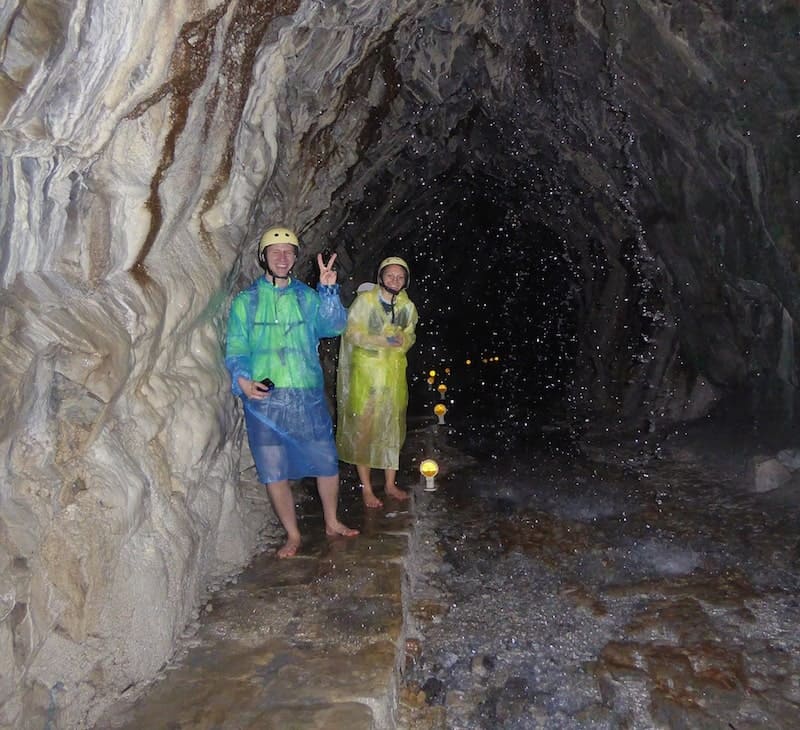
Water poured through the cave roof, sometimes in drips and at other places in torrents. The original trail was built by Taipower in 1984 for a hydroelectric power project that was shelved shortly after. The Water Curtain Cave occurred after the power company accidentally hit an underground water vein during tunnel excavation. The result is that water flows continuously from the roof of the tunnel. Walking barefoot along the wet, narrow path was invigorating.
On the return hike to the trailhead, we encountered a Formosan macaque (rock monkey) occupying a strategic position in the middle of the trail. I’d read about the unpredictability of monkeys and the possibility of an attack without warning, so it was with a great deal of care that I gingerly walked around it.
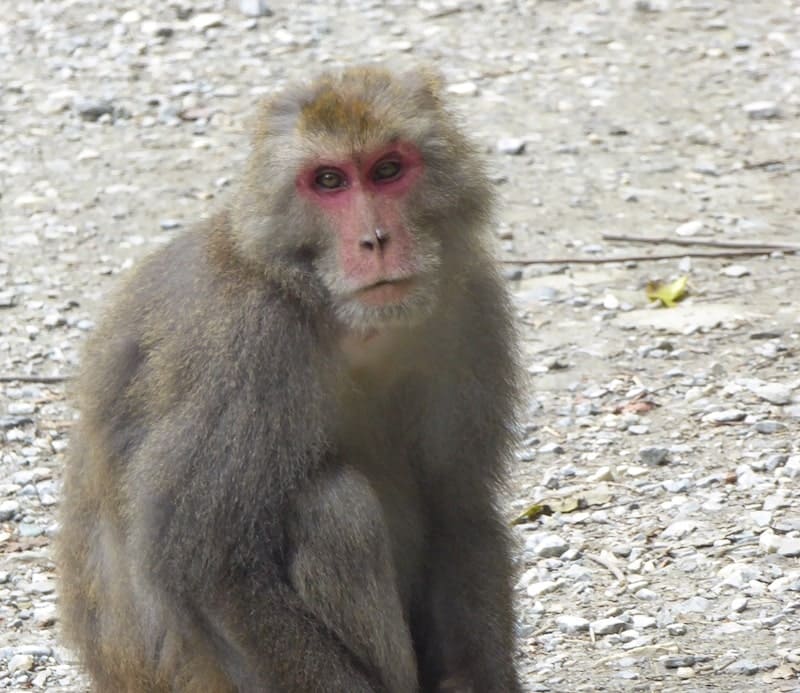
Xiangde Temple
Our next stop was the small village of Tianxiang where we visited the Xiangde Temple, accessed via a suspension bridge across the river. The temple features what is claimed to be the world’s tallest Bodhisattva statue.
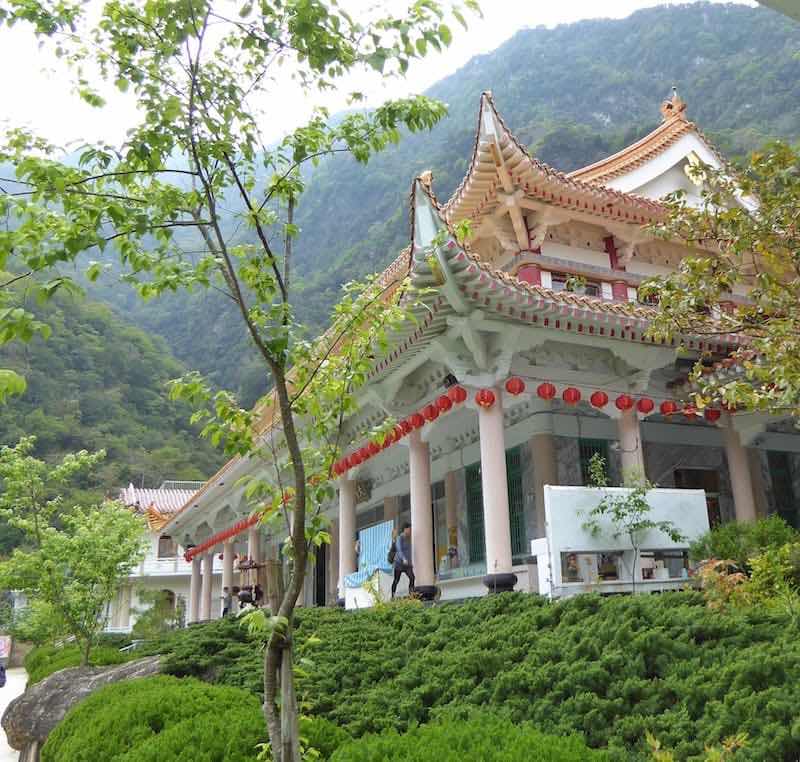
The pagoda, with its dual circular staircases and balconies at various levels, afforded panoramic views of this ‘magnificent and splendid’ slice of heaven.

Swallow Grotto
Adjacent to one of the narrowest and most colourful parts of the canyon, Swallow Grotto might be the most visited and photographed spot in Taroko Gorge.
Beside the grotto is a former section of the highway now used for pedestrians and one-way vehicular traffic. Buses pull up at the grotto’s lower (eastern) end to disgorge tourists sporting safety hats before driving to the parking area at the other end to await their passengers.
The grotto is named after the swallows nesting in the vast number of potholes etched into the grey-black marble of the steep walls of the canyon by the erosive forces of the Liwu River. Traffic and pedestrians move slowly along this half-kilometre slice of the old highway, so it’s possible to continue downhill and cycle through the grotto against the traffic, stopping occasionally to admire the stunning twists and turns of the gorge.
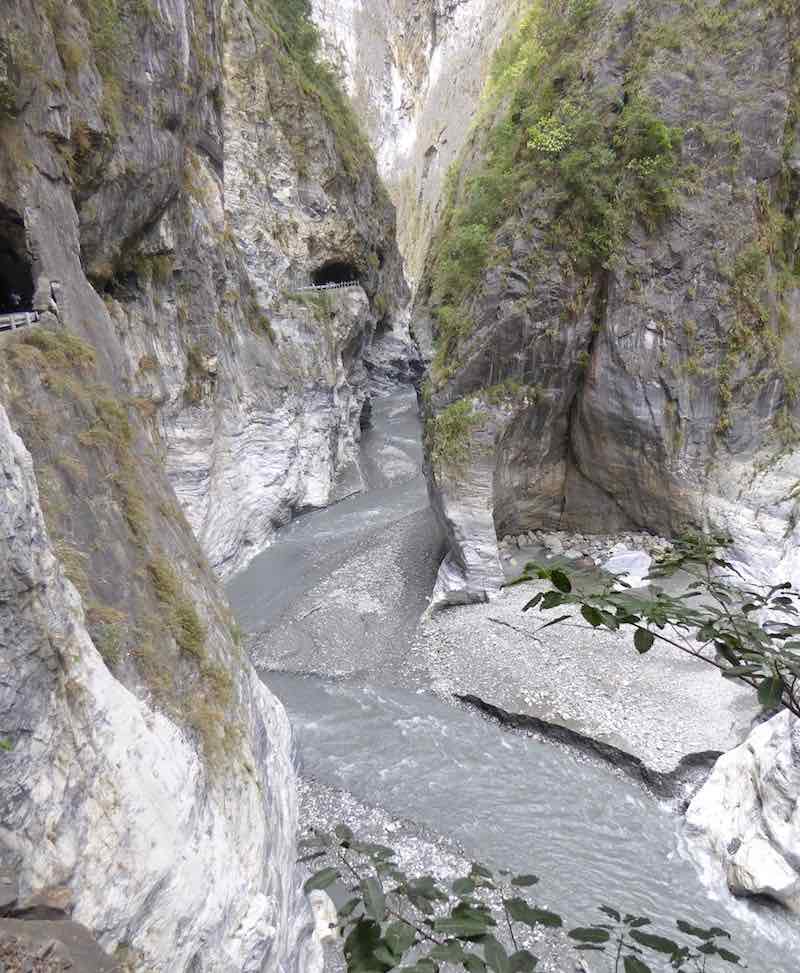
Cycling with others has advantages
Travelling with other cyclists has definite advantages. Given the convenience and efficiency of Taroko Lodge’s bike-and-hike services, chances are you won’t be cycling alone.
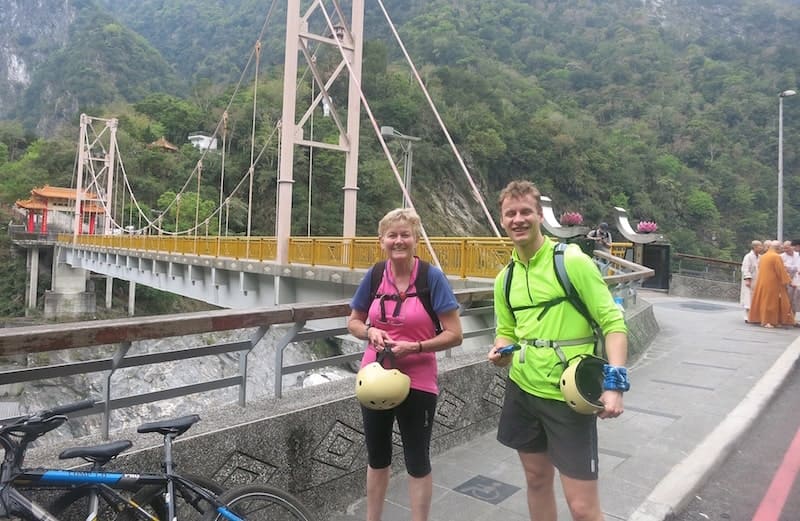
The camaraderie and conversation notwithstanding, the security of travelling in a small group on such a challenging road was comforting. Besides, each person brought handy travel aids useful in different situations. Kai had a headlamp, Birta wore a headlamp as the lead cyclist, and I had a flashlight for hiking in tunnels.
Kai had a waterproof camera for taking pictures when conditions were such that other cameras needed to stay safely stowed. I had mosquito repellant, and Kai had sunscreen that, in both cases, wasn’t required. I also had an unlocked phone with a Taiwan mobile plan in case we needed it. We shared what was in our respective backpack pantries when we stopped for lunch.
A bike and hike is the way to go
The ride down the gorge in the fresh mountain air was a definite highlight of the day, and my short stay in Taroko. I felt for the hordes of tourists in those massive tour buses stopping at designated spots for the obligatory snapping of photographs before climbing back on board until the next stop on the itinerary (for more photos). While travelling by bus is one of the few options for many people to see the gorge, I was grateful to have the opportunity to bike and hike Taroko. We had the luxury of stopping at trailheads of our choosing and combining hiking and cycling for an active and enjoyable exploration of the national park.
Returning to our bikes at each trailhead, we always found them exactly as we’d left them. There was no need to lock bikes or take out insurance against damage or theft. There was no liability on our part in the event of loss or damage. Taiwan has to be one of the best places in the world when it comes to people respecting the property and safety of others. People don’t take what doesn’t belong to them. Of all the countries I’ve visited, it’s the one where I’ve needed to take the least number of precautions to safeguard my possessions and personal safety.
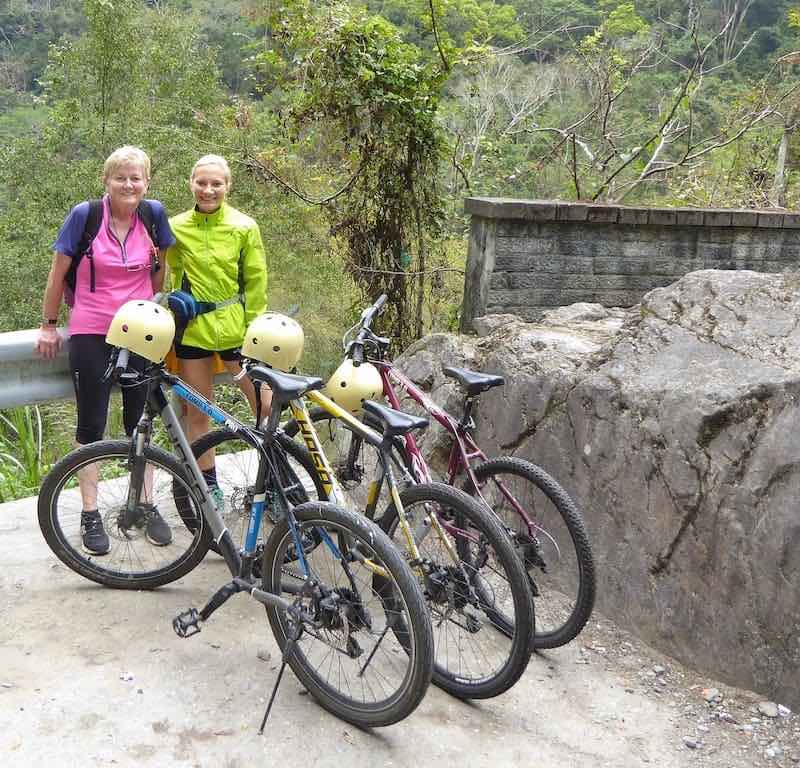
Taroko Lodge
Neither a hotel nor a hostel, Taroko Lodge is registered with the Taiwan Homestay Program.
Rihang is an exceptional host who cannot do enough to satisfy the needs of his guests. He’s constantly on the move, preparing breakfast at times selected by each guest, picking up and dropping off people at the railway station, or coordinating his bike-and-hike services. He will arrange a hiking permit for the Old Jhuilu (Zhuliu) Trail, and he even picked up my train tickets for the return journey to Taipei.
Breakfast is a generous home-cooked meal out on the porch overlooking the grounds. Just before the time indicated by guests to have breakfast, the sound of the coffee grinder lures a person outdoors. The freshly brewed coffee (some of the best I’ve had) is followed by fruit, fried egg, toast, and a selection of spreads (jams and peanut butter), providing a welcome start to the day.
A stop at 7-11 on the way to the park permits the purchase of snacks and picnic items for lunch. For supper, Rihang takes guests to local eateries in Xincheng or Hualien or volunteers to pick up provisions. He knows what to order and guests are guaranteed a delicious meal
The lodge has four spacious guest rooms. I recommend staying at least three nights to allow for a minimum of two full days to explore the park. This means a whole day for the self-guided bike-and-hike tour and another to comfortably enjoy the challenging hike of the Old Jhuilu Trail (and any others you can squeeze into the time available). For a description of my experience, check out Hiking Taroko’s Old Jhuilu Trail.
If you’re looking for a convenient and hassle-free way to explore Taroko Gorge, place yourself in the attentive, responsive, and helpful hands of Rihang Su and his family. The price of accommodation includes breakfast, pickup and drop off at Xincheng station (about two kilometres from the lodge) and transportation to restaurants for supper. And those extras Rihang includes to ensure his guests are enjoying their stay.
Contact Rihang by email at tarokolodge@gmail.com to request availability and prices.
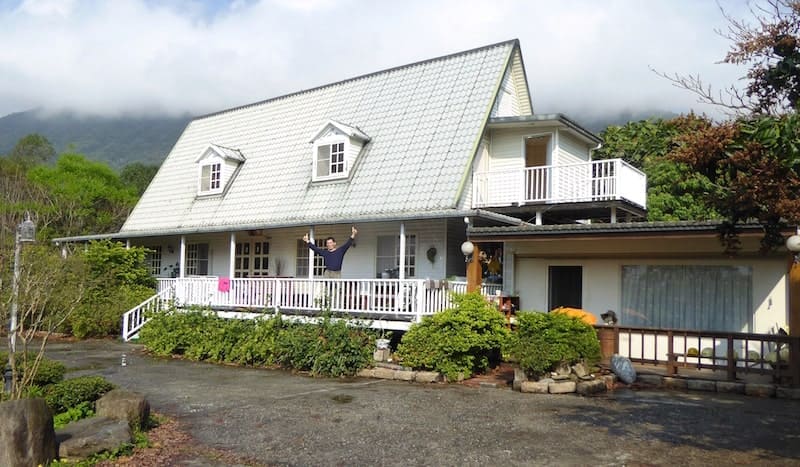
Getting there
Take the train to Xincheng. You may need to take an express train to Hualien and a local train a 15-minute journey to the small town of Xincheng. The digital screens on the trains display each stop in English, and announcements are also in English. The Xincheng station is small, so Rihang’s van will be right at the exit, and Rihang standing at the ticket gate.
What to pack
- You’ll need a light daypack to carry a picnic lunch, rain jacket, and camera.
- If a dip at the Wenshan Hot Spring appeals to you, take a swimsuit and a quick-dry towel.
- Pack a poncho to fully experience the Water Curtain Cave without getting soaked and an umbrella for taking pictures. Also, a lens cloth will come in handy.
- A flashlight is indispensable to navigate tunnels safely.
- If you are planning to hike the Old Jhuilu Trail, hiking poles will make the going much easier, and shoes with good tread much safer.
- Wear light clothing. My three-quarter cycling knicks were perfect for both the bike-and-hike run down the gorge and the hike of the Old Jhuliu Trail (in March).
- Long pants in a light fabric would be more practical in seasons when mosquitoes, wasps, and leeches may be present.
- It’s very humid in this part of the world, and my quick-dry shirts and underwear took two days to dry so pack with this in mind.
- Depending on the season, insect repellent will be necessary.
Might you be interested in my other posts on Taiwan?
- 10 Irresistible reasons to visit Taiwan
- Zhuilu Old Trail Hiking Guide: Taroko National Park, Taiwan
- Yehliu Taiwan guide to bizarre rocks and succulent seafood
- Guide visiting Beitou Hot Springs i Taipei
- Discover Taiwan’s culinary treasures with a Taipei walking food tour
- 18 Mouth-watering examples of the best Taiwanese street food
If you found this post helpful, please share it by selecting one or more social media buttons. Have you experienced the wonders of Taroko Gorge? If you’ve published a blog post, please provide a link in your comments. I’d love to hear from you.
Pin for later?
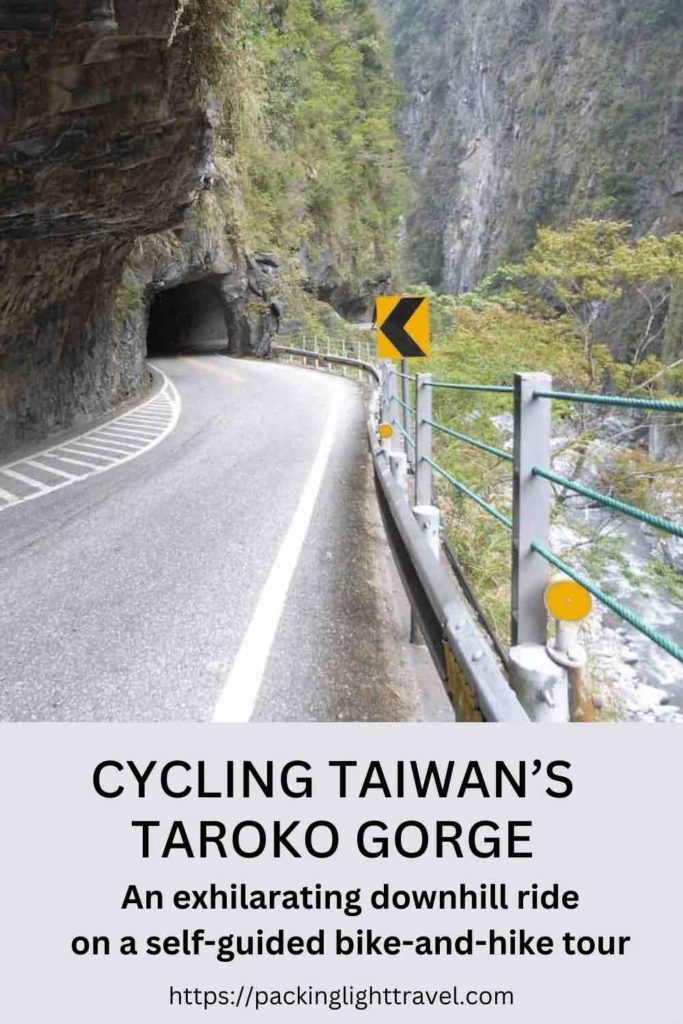
This post is neither sponsored nor solicited. I’ve not received any requests, instructions, or rewards from Taroko Lodge. I paid the full cost of accommodation and services.






Hey this is amazing! I’m going there in two weeks time. I’m thinking of doing the same thing. May I know how long this little adventure lasts? Thanks!
Oh fyi, I only plan for a day hike/bike. Is it sufficient?
Amanda recently posted…Padas White Water Rafting Experience
A day is sufficient to hike most trails as you bike down the gorge, but to experience the Old Jhuilu Trail I’d recommend a second day.
Anne Betts recently posted…Anti-pickpocket gear
Plan for a full day to enjoy several hikes from various trail heads. Pack a swimsuit just in case a refreshing dip looks appealing. Enjoy!!
Anne Betts recently posted…Anti-pickpocket gear
Hi, we will be travelling to Taroko Gorge in September and would like to embark on the bike/hike tour but are concerned about our 10 and 12 year old cycling on these narrow roads and through the dark tunnels. Do we need to worry? Thanks!
Go for it!! Avoid weekends, as these likely have more traffic. The road isn’t built for speed, and drivers take their time. I don’t recall tunnels without lights being a problem but it did feel safer having a light other drivers could see. (Take a flashlight for tunnels on hiking trails.) Rhiang supplied helmets. We were sure to remain close together, and stop only where it was safe to do so. Take a full day to take advantage of so many hiking trails. ENJOY!!
Anne Betts recently posted…How to create a pre-travel checklist
Good coverage of a superb destination. I’ve been to Taroko four times in the last two years, even though I live on the other side of Taiwan. http://bradttaiwan.blogspot.tw/2016/02/tarokos-lushui-trail.html
This is a very helpful article. May I ask for any contact # of Rihangs?We are planning to go there next month.
Thank in advance
You’ve likely found his site (http://www.tarokolodge.tw), and I communicated with him via email (rihangsu@gmail.com) to organize the permit to hike the Old Jhuilu Trail. The contact number programmed into my phone for park pickup is 0922938743. Please give Rihang my regards, and I hope you enjoy your stay.
Anne Betts recently posted…Include Taiwan in your travel plans
That seems like a journey! As a great deal as I would really like to attempt it, I am now not certain if I can continue to exist the notion that I’ll be biking on these edges! It seems frightening! I am not right with heights! You, men, did a superb activity!
Wow your article very informative. Thanks for sharing such a useful post.
Ahhh, this makes me want to check out the waterfall even more. Looks so cool and wet.